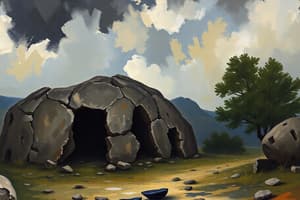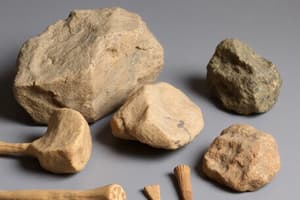Podcast
Questions and Answers
Which of the following is NOT a stone age era?
Which of the following is NOT a stone age era?
- Neolithic
- Protolithic (correct)
- Paleolithic
- Mesolithic
What was a significant consequence of climate changes during the Paleolithic era?
What was a significant consequence of climate changes during the Paleolithic era?
- The development of microliths
- The migration of humans and Neanderthals to new continents (correct)
- The extinction of the Neanderthals
- The development of farming
What is the primary reason for the naming of the Stone Ages?
What is the primary reason for the naming of the Stone Ages?
- The length of time the Stone Ages lasted
- The dominance of stone tools (correct)
- The geographic area where stone tools were first used
- The type of stone people used for building
How did stone tools change from the Paleolithic to the Mesolithic?
How did stone tools change from the Paleolithic to the Mesolithic?
What significant change occurred in human societies during the Neolithic period?
What significant change occurred in human societies during the Neolithic period?
Flashcards
Stone Age
Stone Age
The earliest known period of human history characterized by stone tools.
Paleolithic Age
Paleolithic Age
The Old Stone Age, lasting from 2.5 million to 10,000 BCE, marked by simple stone tools.
Mesolithic Age
Mesolithic Age
The Middle Stone Age, from 10,000 to 8,000 BCE, known for improved stone tools.
Neolithic Age
Neolithic Age
Signup and view all the flashcards
Neanderthals
Neanderthals
Signup and view all the flashcards
Study Notes
Overview of the Stone Age
- The Stone Age lasted 2.5 million years
- It's the earliest known time humans lived on Earth
- Humans used stones for tools
- There are three Stone Ages: Paleolithic, Mesolithic, and Neolithic
- Lithic is another word for rock or stone
Paleolithic or Old Stone Age
- Lasted from 2,500,000 BCE to 10,000 BCE
- This was the longest Stone Age
- Early humans used simple stone tools
- Many early human species lived during this time
- Neanderthals, a subspecies of humans, existed
- Climate changes caused sea levels to fluctuate
- Land bridges allowed migration to continents like the Americas, Australia, and the Middle East
Mesolithic or Middle Stone Age
- Lasted from 10,000 BCE to 8,000 BCE
- Stone tools improved, polished for better feel and function
- Microliths (tiny sharp rocks) became tools
- Serrated knives made from chipped rocks
- Neanderthals became extinct
- Human communities focused on hunting and gathering
Neolithic or New Stone Age
- Lasted from 8,000 BCE to 3,000 BCE
- Stone tools advanced with molding and specific uses
- Domesticating plants and animals meant communities could be permanent
- Food could be grown and harvested from crops
Studying That Suits You
Use AI to generate personalized quizzes and flashcards to suit your learning preferences.




